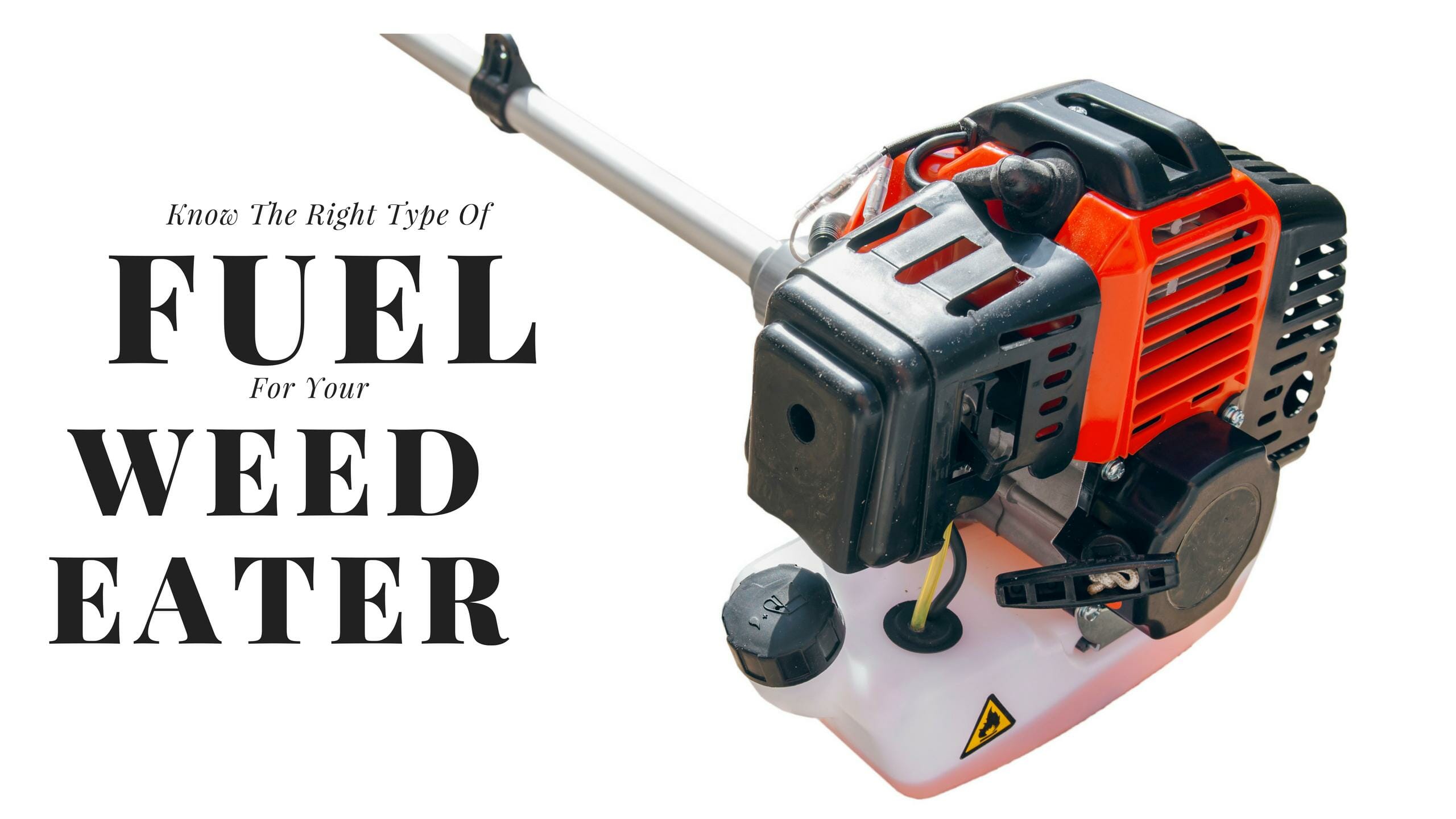The Right Type of Fuel For Your Two and 4-Cycle Weed Eater

Gas weed eaters should be refueled regularly to function properly. The fuel used differs according to the type of string trimmer you use. There are basically two types of gas powered string trimmers: 2-cycle and 4-cycle engines. The 2-cycle string trimmer is lighter and has more power packed in the same sized engine as a 4-cycle. The heavier 4-cycle string trimmer runs quieter with less fumes than the 2-cycle.
Most likely, you own a 2-cycle weed eater but it’s important to check because of the differences in engine design in maintenance. Lets take a look at the 4 cycle case first.
Refueling Your 4-Cycle Weed Whacker
Unlike the 2-cycle string trimmers, 4-cycle units do not require the oil and fuel to be mixed in the gas tank. The weed whacker has its own oil pump that dispenses oil to the piston and crankcase. The fuel used can be the same as you use for your lawnmower.
That doesn’t mean 4-cycle engines are oil-less. You do still need to add oil to the oil reservoir. If you neglect to refill the oil, the piston will likely overheat and wear against the engine. In layman’s terms, that’s not a good thing.
Lubricate the crankcase of the 4-cycle weed whacker regularly to ensure that the weed whacker operates smoothly.
What Kind of Oil is Used in 4-Cycle Weed Whackers?
Use a high-quality oil. Most manufacturers provide factory tested oils for the weed eater. The engine works at a high speed creating heat and friction. When buying oil look for the American Petroleum Institute (API) designation.
There should have been included in your new purchase a small bottle of oil. Keep the empty bottle to measure the amount of oil required. Tilt the engine and open the oil cap. Empty the bottle of oil into the hole. Use a funnel if you threw the empty bottle away by accident. Check the oil level to prevent overflowing.
You’ll need to change the oil roughly after 25-30 hours of usage. Replace with clean oil. The first oil change should be done after about 10 hours of working with your weed whacker.
Refueling Your 2-Cycle Weed Eater
2 cycle engine design is much simplier. That’s good in that there are less parts to break, but it does mean more work for you. With no oil pump, the engine of a 2-cycle weed eater is lubricated with a fuel-oil mixture.
What Kind of Oil Is Used in Your 2-Cycle Weed Eater?
The 2-cycle air-cooled engine requires the exact fuel-oil mixture to keep the piston lubricated. Without the fuel-oil mixture, the engine can seize. Too little oil in the mixture will scar the piston.
What is the Exact Ratio Unleaded Gasoline to Oil You Should Add to The String Trimmer?
The exact ratio differs from brand to brand. The most common ratios ar 40:1 and 50:1, but others exist as well. A 40:1 ratio is what most weed eater brands require (the ratio means 40 oz. of gasoline for every ounce of oil). The 40:1 ratio equals 3.2 ounces of oil for every 1-gallon tank of fuel.
Don’t assume you have a 40:1 ratio engine. Make sure that you check your manual. There are brands that require a 50:1 ratio which equals 2.6 ounces oil for 1-gallon fuel. If you’re not sure, check the correct ratio stamped onto the fuel tank or cap.
It is recommended to use at least 87-octane with maximum 10% ethanol.
The use of high-quality oil is essential. Although your lawnmower oil can be used in a 4-cycle string trimmer, it is not recommended for a 2-cycle weed whacker. Neither is the oil for your snow mobile or automobile adequate for a 2-cycle engine.
I happen to live in an area where non-ethanol fuel is sold, primarily for refueling boat engines. If you are this lucky, use non-ethanol formulated fuel in your 2-cycle engine. Really. It’ll save you time and hassle down the road.
If you are forced to use an ethanol version of gas, use at least a 89-octane fuel. You also don’t want to store more than 30 days of non-stabilized fuel. Water has a way of working into the gasoline from the outside air. Once inside, it’ll separate from the fuel. Water and engines don’t mix well.
How Do You Know You’ve Added the Wrong Fuel-Oil Ratio to The Fuel Tank of The String Trimmer?
Sometimes the manufacturer’s manual is unclear and you’re not sure you’ve mixed the correct ratio. Perhaps you accidentally mixed the wrong formula. How do you know you’ve made a mistake without making it worse and permanently damaging the engine? Here are a few pointers:
- If you’ve added too little oil, there’s a loss of power when the engine is hot. Another sign is that the engine feels or ‘smells’ hot. This smell is hard to describe, but think of the fumes an engine gives off as it begins to overheat. It’s metallic in nature.
- With too much oil, you will notice blue smoke or the excess oil drips from the string trimmer exhaust.
- If the engine doesn’t want to start, there may not be enough fuel-oil mixture added or the oil or gas is older than 3 months or dirty.
- If the fuel contains more than 10% ethanol it’s likely the weed wacker engine will run irregularly. The longer the gas sits in the tank, the more likely you are to have problems.
There is a greater danger of seizing the engine when too little oil is added than with excess oil. If you really don’t know and can’t seem to find any documentation, you can run most engines for a little while with a 50:1 ratio without too many problems. This isn’t a long-term strategy though.
If you see any of the above signs, stop the string trimmer immediately. Drain the fuel-oil mixture and mix a fresh blend.
How To Change the Fuel-Oil Mixture of the 2-Cycle Weed Whacker
To re-fuel your weed whacker you need the following:
- Eye and ear protection
- Gas container
- 2-Cycle engine oil for specific weed whacker brand
- Fresh Fuel
- Measuring cup and funnel
- Gas container for mixing the fuel and oil
Step 1: Wear eye and ear protection against accidental fuel spillage. Unplug the spark plug wire from the spark plug. Place a plastic container on the ground to avoid fuel spills on the ground.
Step 2: Take off the cap of the fuel tank. Turn the weed eater upside down to drain fuel from the tank. Recycle the fuel mixture; do not spill it onto the lawn or ground. It can contaminate the nearby water as the oil seeps into the ground.
Step 3: Prepare the right mixture of fuel and oil. First, pour the mixture into the gas container. Do not mix directly in the fuel tank. Gently shake the mixture to blend it properly before filling the fuel tank.
Step 4: Reposition the spark plug wire to the spark plug as before.
Take-away
If you are not going to use the string trimmer in the next 30 days, drain the fuel from the fuel tank. When emptied, start the engine until it stops. This will prevent clogging from old fuel that is absorbing water from the atmosphere. Once it’s in your fuel line, it’s a lot of work to fix the problem correctly.
If you’ve mixed the ratio correctly and the string trimmer doesn’t want to start, it may be other maintenance issues such as spark plugs or a dirty air filter.

